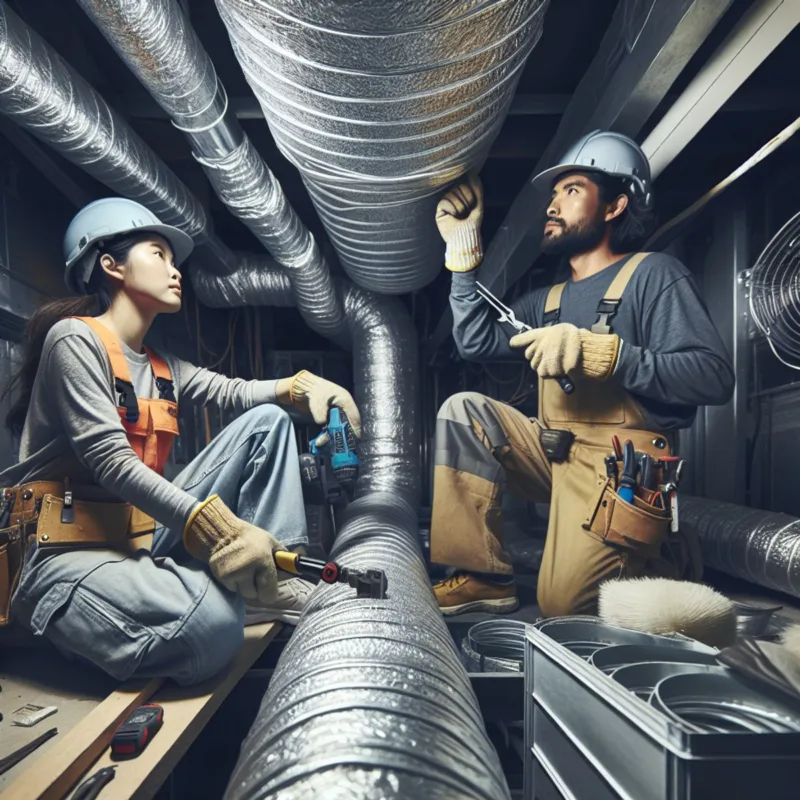Table of Contents Show
Introduction
The concept of home comfort has transformed drastically over the years, with HVAC (Heating, Ventilation, and Air Conditioning) systems becoming a staple in the modern household. However, understanding the cost of installing HVAC ductwork per square foot can feel as complex as solving a Rubik’s cube blindfolded.
Installing an HVAC system is no small task—it’s a significant investment that involves numerous components including heating, cooling, and ductwork. The cost of installation can be quite variable, influenced by factors that stretch far beyond just the system itself.
So, let’s shed some light on this mystifying topic. This article will serve as your compass guiding you through the labyrinth of HVAC system installation costs. We’ll delve into the nitty-gritty details from materials to labor costs, discuss additional charges you might not have considered, and even explore how regional variations can impact your final bill.
Stick around to uncover the key elements and hidden charges that shape the cost to install HVAC ductwork per square foot. Packed with real-life examples and practical tips, this guide aims to help you navigate this significant investment with confidence and foresight.
Understanding the Average Cost of HVAC System Installation

When it comes to understanding the average cost of HVAC system installation, it’s a bit like piecing together a puzzle. Each piece represents a different factor that can influence the final cost. The picture becomes clearer once you start putting these pieces together.
Factors Affecting HVAC System Installation Costs
Residential HVAC system installations typically fall within a certain cost range. For new construction projects, the costs tend to hover around $1.75 to $2.50 per square foot. That might seem straightforward, but let’s not forget about those puzzle pieces. This price range is an average, meaning actual costs can be lower or higher depending on various factors like:
- Material type
- Specific requirements
- Location
To shed some light on this topic, let’s consider an example.
Case Study: Mr. Smith’s New Home
Mr. Smith decided to build his dream home and needed an HVAC system installed. His house is a 2000-square-foot property located in the city center, which already brings us to an estimated cost between $3,500 and $5,000 for the HVAC installation alone (2000 sqft x $1.75-$2.50).
But we’re not done yet! That is just the base cost for installing the HVAC system itself. Ductwork installation adds on an additional expense – typically around $10 to $20 per linear foot for materials. Assuming Mr.Smith’s house required 100 linear feet of ductwork (a rough average for a 2000 sqft home), this would add another $1,000 to $2,000 to his overall costs.
So now we’re looking at a total cost between $4,500 and $7,000 (before labor costs). And remember this is for new construction – retrofitting an existing structure with new ductwork can potentially drive up costs even more!
The numbers can seem daunting at first glance, but they serve as a reminder that understanding the average cost of HVAC system installation is about more than just a single figure. It’s about considering all the factors at play, from the size of your property to the complexity of the installation.
Keeping your air ducts clean is also crucial for maintaining an efficient HVAC system. This informative article uncovers what you might expect to pay for professional air duct cleaning services, which is another important aspect to consider.
As we delve deeper into the topic, you’ll discover how different elements contribute to these costs and what you can do to manage them effectively.
Breaking Down the Costs: Materials, Labor, and More
When it comes to ductwork installation costs, it’s important to understand the contributions of different components to the overall cost.
Ductwork Materials: Options and Cost Implications
In HVAC system installation, there are various ductwork materials available. Here are the options and their cost implications:
- Galvanized Steel: This is the most common and durable material, costing around $10 – $20 per linear foot.
- Aluminum: Lightweight and easy to install, but slightly more expensive at $11 – $22 per linear foot.
- Fiberglass: Known for its insulation properties but less durable. Costs approximately $10 – $21 per linear foot.
- Polyurethane and Phenolic Insulation Boards: These materials serve as both ductwork and insulation, with costs ranging from $16 – $26 per linear foot.
Labor Costs: An Inside Look
Labor expenses make up a significant portion of the total HVAC ductwork installation cost. Several factors influence these costs:
- Experience and Skill Level: Highly skilled installers or contractors with extensive experience may charge higher labor costs. Their expertise ensures a quality job.
- Job Complexity: Projects with intricate design requirements or challenging conditions (such as tight spaces or high ceilings) often result in higher labor costs.
- Location: Geographic location also affects labor costs due to variations in living expenses across regions.
- Emergency or After-Hours Work: Urgent installations or work done outside regular hours may incur additional service charges on top of standard labor costs.
Remember, while choosing cheaper options might seem tempting, it may not always be the best decision in the long run. Investing in quality materials and skilled labor can prevent future issues and additional expenses.
In the next sections, we’ll explore other factors influencing HVAC ductwork installation costs and how incentives can help offset some of these expenses. It’s important to consider the bigger picture when planning your HVAC system installation.
Other Key Factors Affecting the Total Cost of HVAC Ductwork Installation
When it comes to installing HVAC ductwork, several factors can influence the overall cost. Understanding these factors can help you plan your budget more effectively. Here are some key considerations:
If you’re working on a new construction project, you may have some advantages when it comes to HVAC installation costs. Here’s why:
- No existing structures to work around: Unlike retrofitting an HVAC system into an existing building, new construction projects allow for more freedom in designing the layout of the ductwork. This can result in a more efficient and cost-effective installation process.
- Bulk material purchases: Contractors working on large-scale developments can often take advantage of bulk purchasing discounts when buying materials for the HVAC system. This can help reduce costs.
- Streamlined labor efforts: When all tradespeople involved in the construction project collaborate from the beginning, it’s easier to coordinate schedules and streamline labor efforts. This can lead to time savings and potentially lower labor costs.
Where you’re located can also have a significant impact on the cost of your HVAC installation. Here’s how:
- Climate considerations: Areas with extreme temperatures, whether hot or cold, may require special insulation or system capabilities to ensure optimal performance. These additional requirements can add to the overall cost.
- Regional regulations: Local building codes and standards vary, and these regulations can dictate which types of HVAC systems are allowed in a particular area. Compliance with these regulations may affect the selection and cost of your system.
- Labor market rates: The cost of skilled labor varies from one region to another. In areas with high demand for HVAC contractors and limited supply, labor rates may be higher compared to regions with a more competitive market.
For example, in a city like New York with strict building codes and a high demand for skilled labor, the cost of installing ductwork can be significantly higher than the national average. On the other hand, areas with lower living costs may have more affordable pricing for similar work.
Considering Location-Specific Challenges
It’s also important to consider any unique challenges that your location may present. These challenges can affect both the installation process and the overall cost. Some examples include:
- Limited space for equipment in urban sites
- Difficulty accessing job sites in remote or rural areas
Each location has its quirks, and these factors can impact the complexity and duration of the installation process.
By taking these factors into account early on in your planning process, you can develop a more accurate budget that reflects the specific needs of your project as well as its environmental context.
Additional Costs to Consider During HVAC System Installation
When it comes to installing your HVAC system, it’s important to look beyond the initial price tag. While the cost of the unit and ductwork may seem like the main expenses, other factors can impact your overall budget. Here are two additional costs to keep in mind:
1. Insulating Ducts: A Critical Expense for Efficiency
Insulating your ducts is a crucial step in ensuring energy efficiency and comfort in your home. Here’s why it’s worth the investment:
- Energy Savings: Properly insulated ducts help minimize heat loss or gain during air distribution, resulting in lower energy consumption and utility bills.
- Improved Comfort: Insulated ductwork helps maintain consistent temperatures throughout your home, eliminating hot or cold spots.
- Moisture Control: By preventing condensation on duct surfaces, insulation helps prevent mold growth and potential damage to your property.
When it comes to cost, the price for insulating ducts typically ranges from $0.95 to $2.00 per square foot. The exact amount will depend on factors such as the type of insulation material used and the desired level of insulation (measured by its R-value). Higher R-values provide better insulation but may come at a higher cost.
2. Permit Requirements: Don’t Overlook Compliance Costs
Obtaining the necessary permits for your HVAC installation is essential to ensure that the work is done safely and in compliance with local building codes. Here’s what you need to know:
- Permit Fees: The fees for HVAC permits can vary significantly depending on your location and the scope of the project. On average, you can expect to pay anywhere from $50 to over $500.
- Inspection Costs: Some jurisdictions require inspections during or after the installation process. These inspections may be conducted by city officials or third-party inspectors and can add to your overall expenses.
- Potential Delays: The permit application and approval process can take time, potentially leading to delays in starting or completing your project. These delays could impact labor costs or project timelines.
It’s important not to overlook the importance of permits, as failing to obtain them can result in fines or complications when selling your home in the future. Compliance with building regulations is crucial for maintaining the value of your property and ensuring the safety of its occupants.
By considering these additional costs upfront, homeowners can better estimate the total investment required for their HVAC system installation. However, it’s essential to keep in mind that these are just a couple of factors that can influence your final expenses. There may be other variables specific to your situation that should be taken into account as well.
Estimating the Total Cost: Case Studies and Practical Tips
Let’s delve into an example that highlights the influence of retrofitting on the cost of an HVAC system installation.
Case Study: Retrofitting HVAC System
Consider a 2,000-square-foot home where an existing older HVAC system requires an upgrade. Naturally, retrofitting the house to accommodate a modern ventilation system installation poses unique challenges, which are reflected in the costs.
The upgrade may necessitate replacing or rerouting ductwork to optimize airflow. Expect such modifications to boost ductwork installation costs, which usually hover around $10 to $20 per linear foot. For a house this size, total ductwork could easily stretch to 100 linear feet (or even more), pushing costs between $1,000 and $2,000.
Next comes the actual HVAC unit. A mid-range efficiency unit could run anywhere from $5,000 to $10,000. Add in labor costs ranging from $5.35 to $7.75 per linear foot of ductwork, and suddenly retrofitting becomes a pricey proposition.
Other expenses like removal and disposal of the old unit or asbestos abatement (if necessary) add more numbers to the final tally. And remember that one-off costs such as permit fees can also factor into the overall budget.
So while every retrofit project is unique with its own set of variables, it’s not uncommon for homeowners to face a total bill ranging from $7,000 up to $16,000 or more.
Now that you have an idea about how retrofitting can impact costs let’s arm you with some practical tips for conducting your ventilation system installation cost analysis:
- Request Multiple Quotes: Don’t settle for the first quote you receive. Gather multiple estimates from different contractors and compare what they offer in terms of value for money.
- Understand Your Specific Needs: The size of your home, local climate conditions, and your efficiency preferences will all play a part in determining the most suitable HVAC system for your needs.
- Account for Unforeseen Costs: Allow a cushion in your budget for unexpected costs that may arise during installation, like the need for additional ductwork or unforeseen structural challenges.
- Factor in Long-Term Costs: Consider the ongoing operating costs of different HVAC systems. An energy-efficient unit might be more expensive upfront but could save you money in the long run through lower energy bills.
This section has unpacked some of the complexities involved in estimating HVAC installation costs. But don’t switch off just yet; there’s more to explore on this topic, including how geographical location and regional climate can impact your project’s bottom line.
When budgeting for HVAC ductwork installation, it’s smart to factor in how regional climate conditions and labor rates can sway your final bill. Let’s delve into these geographical influencers that might just have your calculator doing double takes.
Regional Climate Impact on Cost
Why does climate matter?
Here are a few ways in which climate can affect the cost of your HVAC ductwork installation:
- HVAC System Type and Size: Regions with extreme temperatures may require more robust systems. A beefier setup in Minnesota, because you’re not just chilling your soda cans, could cost more than the same square footage in milder Oregon.
- Insulation Needs: Places like Arizona aren’t just testing your ability to stay hydrated. The scorching summers mean you’ll need top-notch insulation around ductwork to keep cool air from turning into a mirage. Better insulation equals higher costs.
- Humidity Factors: High humidity regions are like a friend who always overstays their welcome. It demands dehumidifying features in HVAC systems to prevent mold—a feature that could add weight to the price tag.
Regional Labor Rates
Does geography dictate labor costs? Absolutely.
Here are a few reasons why labor rates can vary based on location:
- Supply and Demand: In cities booming with new homes and renovations (hello, Austin!), skilled labor is in high demand, which can push rates higher. Conversely, quieter areas might offer more budget-friendly numbers.
- Cost of Living: It’s no secret—areas with a steeper cost of living tend to have higher labor costs because your technician also needs to afford their local artisanal toast.
- Specialization Required: Some climates necessitate specialists who can install systems capable of battling against either Hades-level heat or Arctic-like colds. Specialists typically command higher fees.
By understanding these regional nuances, you’re better equipped to forecast the financial forecast of your HVAC installation without being caught off guard. Keep these variations in mind while gathering quotes—the difference between regions can be as stark as night and day.
Now, let’s shift gears slightly and look into another aspect that could lighten your wallet or potentially put some cash back into it—incentives.
Incentives to Offset Your Costs: Tax Credits and Rebates for HVAC System Installation
When it comes to HVAC system installation, a silver lining exists in the form of available tax credits and rebates. These incentives can significantly offset the initial outlay, making energy-efficient HVAC systems more affordable.
Tax Credits for Promoting Energy Efficiency Through HVAC System Installations
The federal government offers tax credits to homeowners who invest in energy-efficient HVAC systems. The Non-Business Energy Property Tax Credit allows taxpayers who install energy-efficient systems to claim a credit of 10% of the cost up to $500 or a specific amount from $50-$300. Eligible systems include:
- Central air conditioning
- Heat pumps
- Boilers
- Advanced main air circulating fans
On top of that, the Residential Renewable Energy Tax Credit covers 26% of the cost of an energy-efficient system that utilizes renewable sources such as geothermal heat pumps. This credit is available through December 31, 2022.
Potential Rebates to Help Homeowners Mitigate the Upfront Costs
Aside from tax credits, numerous rebates are offered by utility companies, state programs, and HVAC manufacturers. These can help mitigate the upfront costs associated with HVAC system installations.
Utility companies often provide rebates for installing high-efficiency HVAC systems. For instance, Pacific Gas and Electric (PG&E) offers up to $300 rebates for qualifying high-efficiency central air conditioners or heat pumps.
States also have their rebate programs. The Massachusetts Clean Energy Center (MassCEC), in collaboration with the Department of Energy Resources (DOER), runs a program offering rebates of up to $12,000 for installing air-source heat pump systems.
HVAC manufacturers occasionally offer promotional rebates on specific models or when you purchase through a particular dealer. It’s worth checking manufacturer websites or contacting local dealers for any current promotions or discounts.
Bear in mind that eligibility criteria and amounts vary for each program. Hence, it’s crucial to research and understand these incentives well to make the most out of your HVAC system investment.
Conclusion
As this guide illustrates, the cost to install an HVAC system with ductwork per square foot isn’t a one-size-fits-all figure. A myriad of elements come into play, each impacting the final price. Material choices, labor costs, regional variations, and whether you’re dealing with a new build or retrofitting an existing home all contribute to your bottom line.

Evaluating Individual Project Needs
A careful evaluation of your personal project needs is paramount for achieving a realistic cost estimation. Remember, every home is unique, which means no two HVAC installation projects are identical.
Here are a few suggestions:
- Assess Your Home: Evaluate your home’s size, layout, and current insulation levels. These factors can significantly influence the type and size of the HVAC system you’ll need.
- Get Multiple Quotes: Don’t settle for the first estimate you receive. It’s wise to collect quotes from multiple HVAC professionals. This way, you can compare costs and services to ensure you’re getting the best value.
- Consider Efficiency Ratings: High-efficiency units may come with higher upfront costs but can save money in the long run through reduced energy bills.
- Factor in Potential Rebates and Tax Credits: As discussed earlier, you may be able to offset some installation costs through available tax credits and rebates.
The Bottom Line
While installing an HVAC system with ductwork can be a significant investment, it can enhance comfort in your home and potentially increase its value. By understanding the factors that influence the cost and actively seeking ways to optimize your budget, you’ll be well-prepared to make informed decisions about your HVAC installation project.
FAQs (Frequently Asked Questions)
Factors affecting HVAC system installation costs include the size of the home, the type of HVAC system being installed, the complexity of the ductwork installation, and any additional features or upgrades desired.
The costs involved in ductwork installation include materials such as ducts, insulation, and fittings, as well as labor expenses for the installation process.
Some key factors affecting the total cost of HVAC ductwork installation include the size of the home, the complexity of the ductwork design, any unique challenges presented by the location, and any additional features or upgrades desired.
Geographical location can impact HVAC ductwork installation costs through variations in labor rates, permit requirements, regional climate impact on cost, and potential incentives such as tax credits and rebates.
Insulating ducts is considered a critical expense for efficiency because it helps prevent energy loss, reduces utility bills, and improves overall HVAC system performance by maintaining proper temperature control.
Incentives such as tax credits and rebates are available to help homeowners mitigate upfront costs associated with HVAC system installation. These incentives promote energy efficiency and can provide financial relief for qualifying installations.
Citation
- Bhatia, A. 2014. HVAC – Design of Air-Conditioning Ducts. CreateSpace.
- Jones, David. 2013. ‘Estimating Ductwork Cost.’ Video, 15:06. https://www.youtube.com/watch?v=pIRz6NNlqG0.
- The Practical Study. 2018. ‘How to calculate square foot of a duct.’ YouTube video, 17:45. https://www.youtube.com/watch?v=eISsMdj1N5w. Accessed January 15, 2024.
- Jones, David. 2013. ‘Estimating Ductwork Cost.’ Video, 15:06. https://www.youtube.com/watch?v=pIRz6NNlqG0.











